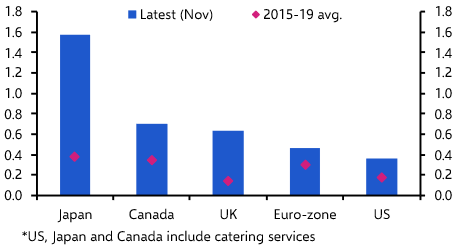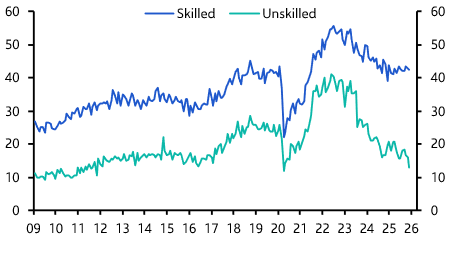Energy prices are dominating the headlines, but the current inflationary surge is also about what’s happening with global food supplies.
We estimate that higher food prices have accounted for about one quarter of the increase in inflation in advanced economies over the past year, and around one-third of the increase in inflation in emerging economies. Many of the factors that are driving energy prices are also behind the surge in food prices – and they share many of the same implications for policymakers.
Much like energy, the increase in food prices has been driven to a large extent by shifts in global commodity prices and, by extension, the war in Ukraine. It is for good reason that Russia and Ukraine are known as the “breadbasket of the world” – together they account for just under a one-third of global wheat exports and one-fifth of global corn exports. The supply disruptions caused by the war have caused wheat prices to jump by 50% and the price of corn to increase by 30%. But they have also given a lift to their substitutes. Soybean prices have increased by around 20% since the war began. (See Chart 1.)
Chart 1: Wheat, Corn and Soybean prices (Jan 1st = 100)
 Sources: Refinitiv, Capital Economics
Sources: Refinitiv, Capital Economics
What’s more, there are powerful feedback loops within commodity markets. Their intensive use of heavy machinery, fertiliser and transportation means that energy is a significant input cost to agricultural production. As Chart 2 shows, big swings in energy prices have been associated with corresponding moves in agricultural commodity prices, so the rise in energy prices caused by the war itself helped to push up global food prices.
Chart 2: S&P GSCI Agricultural Index & Brent Oil Price
 Sources: Refinitiv, Capital Economics
Sources: Refinitiv, Capital Economics
Both food and energy also account for large shares of the basket that government statisticians use to measure changes in consumer prices. In fact, in all countries, food accounts for a much larger share of consumer spending than energy. (See Chart 3.) This means that, compared to other goods, changes in food prices can have a much larger direct impact on headline inflation. Furthermore, food prices are highly visible, suggesting they could play a greater role in shaping inflation expectations. Unlike prices of goods such as used cars and televisions, households are regularly exposed to changes in food prices as part of their daily or weekly shops. Significant and sustained price increases can start to affect their inflation psyches.
Chart 3: Food and Energy Weights in CPI (%)
 Sources: Refinitiv, CEIC, Capital Economics
Sources: Refinitiv, CEIC, Capital Economics
For central bankers, surging food prices pose a similar challenge to surging energy prices in that there’s little they can do to tackle them directly. Admittedly, the general tightness of the labour market might be contributing to higher food prices in a way that it’s not with energy. In the US, higher wage costs may be pushing up restaurant prices which, unlike in most other countries, are included in the food consumer price index under the “food away from home” component. But the future path of food inflation will be determined to a large extent by movements in global agricultural markets. There is little that central banks can do to influence this, particularly when the current high level of prices is rooted in supply-side problems.
Finally, as with energy, the surge in food prices will have implications beyond just its inflationary impact. Sharp increases in both food and energy prices have in the past been a precursor to social unrest, particularly in emerging economies. For example, public anger about food prices fuelled the ‘Arab Spring’ uprisings starting in 2010. The war in Ukraine has also raised questions around food and energy security that may ultimately cause governments to diversify supplies, as well as mean that food export bans are deployed more frequently as countries strive for self-sufficiency. The legacy of the latest commodity shock will play out over years, not months.
Recent history suggests that large spikes in agricultural prices can be followed by equally large falls. (See Chart 4.) And there are several factors – including relatively large stocks of agricultural products – that could create the backdrop for sharp price falls over the coming quarters. But risk premia in agricultural markets are likely to remain structurally higher, and elevated energy prices will continue to keep upward pressure on food production costs. Agricultural prices are notoriously difficult to forecast, not least because they are particularly vulnerable to shocks such as war and extreme weather events. That said, we think that, while prices may moderate a little over the second half of this year, they will remain elevated by the standards of the past few years.
Chart 4: S&P GSCI Agricultural Price Index
 Sources: Refinitiv, Capital Economics
Sources: Refinitiv, Capital Economics
As it happens, this should still mean that food inflation starts to fall over the coming quarters. (See Chart 5.) Inflation, after all, measures the rate at which prices change – so even if food prices stabilise at their current high level, food inflation will drop back. But this would still mean that net importers of food – notably economies in Europe – have suffered a significant deterioration in their terms of trade, which will weigh on real incomes and GDP. And even if food inflation does eventually moderate, as we expect, it will only do so against a backdrop of tight labour markets and widespread concerns that inflation expectations could become unanchored.
Chart 5: S&P GSCI Agricultural Index & Contribution of Food to Headline Inflation in DMs (forecasts in dotted lines)
 Sources: Refinitiv, Capital Economics
Sources: Refinitiv, Capital Economics
For a central banking establishment that’s already nervous about inflation running out of control, high rates of food price inflation in the short term will be just another reason to pursue a relatively aggressive normalisation of monetary policy.
In case you missed it:
- Our Chief UK Economist, Paul Dales, argues that the markets are under-pricing the chances of a 50bp hike in interest rates at this week’s MPC meeting.
- Our Chief Asia Economist, Mark Williams, explains why hopes that China’s government might direct more policy support to households will be disappointed.
- Finally, we have launched a dedicated webpage that pulls together all of our research on the macro and market consequences of higher interest rates – clients can view it here.



